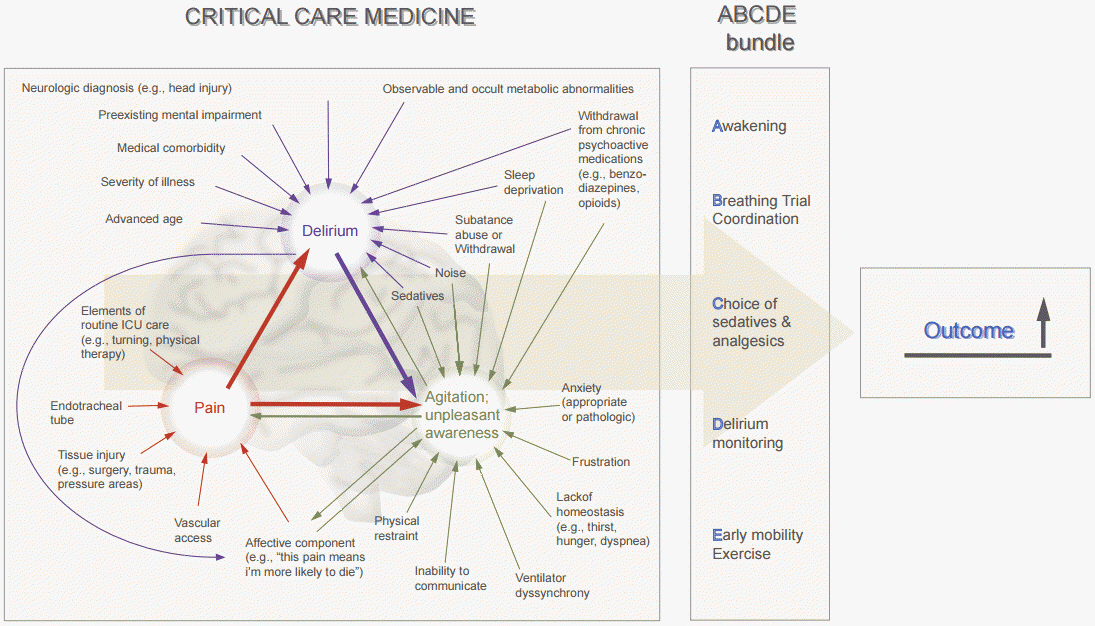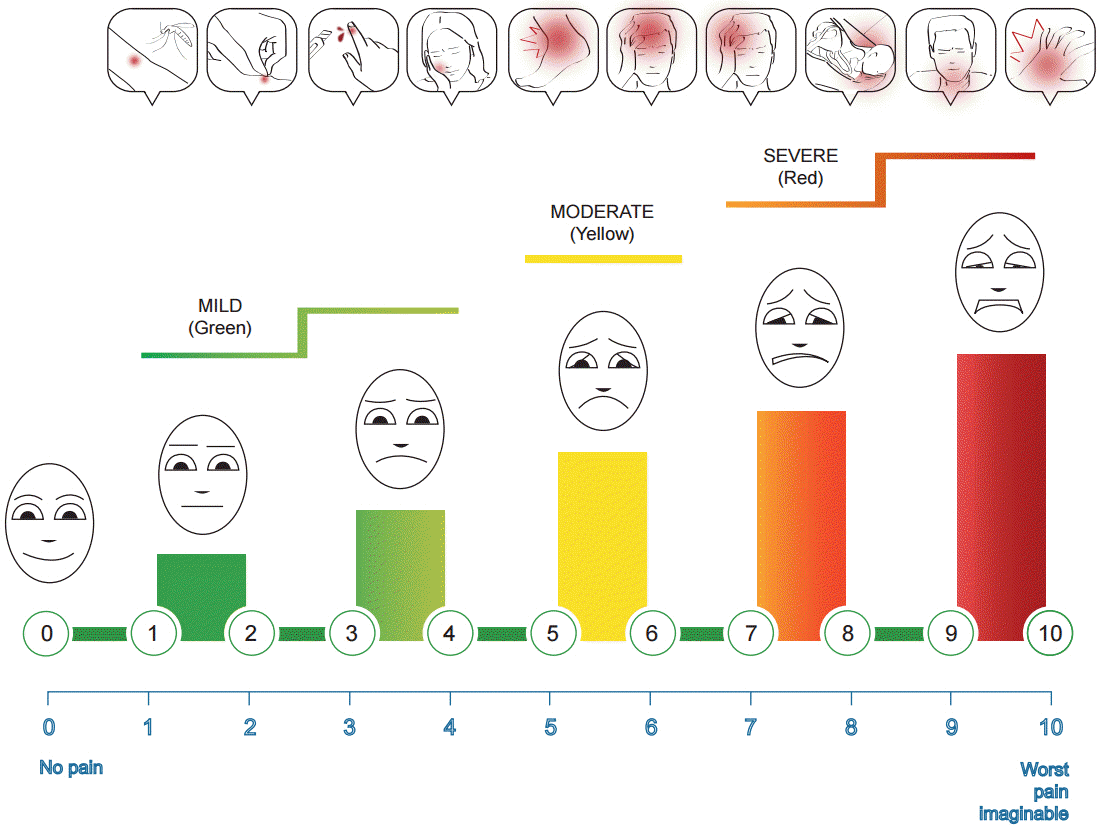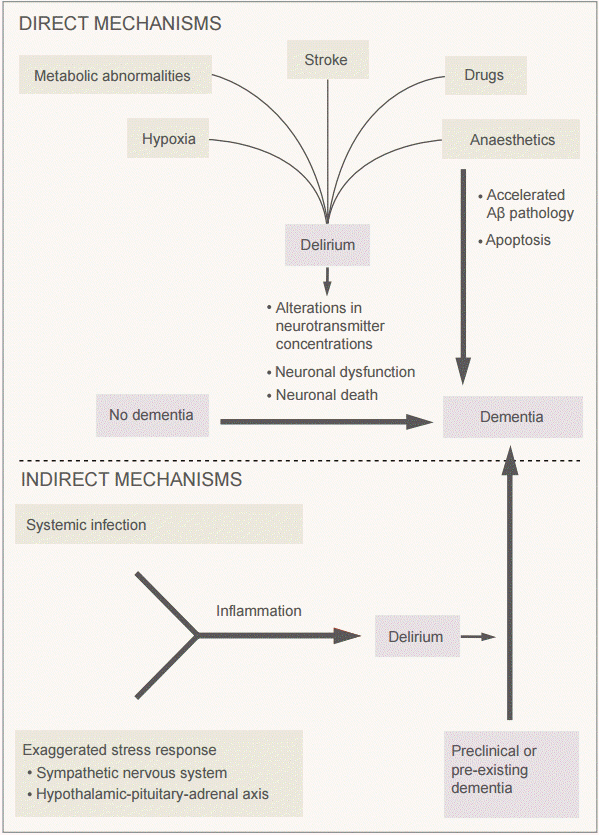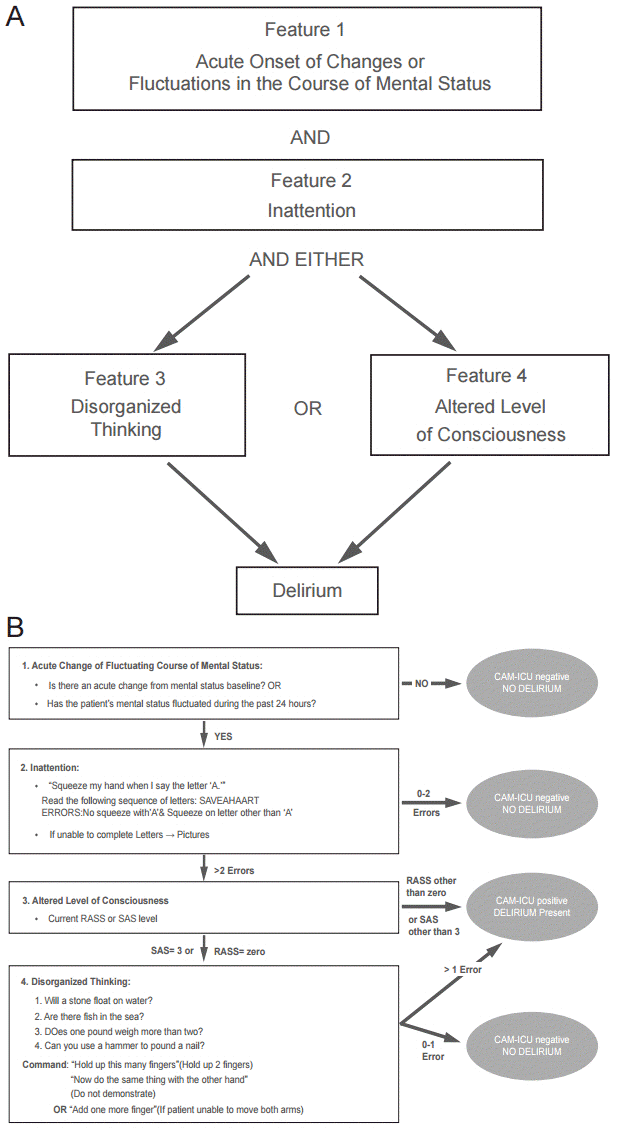서 론
한 연구에서 중환자실에 입원한 환자가 기억하고 있는 경험 중 기도 내 삽관으로 인한 ‘통증’은 가장 흔한 것이었다[1]. 또한 중환자실의 환자들은 다양한 원인으로 발생하는 ‘초초’로 인해 갑작스럽게 기도삽관튜브나 정맥주사를 스스로 빼기도 하여 중환자실에서 적지 않은 문제를 야기한다. 이러한 결과는 환자에게 부정적인 예후를 가져올 수 있고 이를 조절하기 위한 진정제의 과도한 사용으로 부작용이 발생할 수 있다[2]. 중환자실에서 환자에게 평안함과 안전을 제공해야 한다는 궁극적 목적은 통증과 진정을 위한 약물적-비약물적 방법의 체계적 도입이라는 수식으로 귀결되고 있다[3]. 이러한 방법들은 기계환기기를 사용하고 있는 중환자에게 편안하게 숨을 net쉴 수 있게 하고 치료예후를 항상시키는 것으로 알려져 있다. 특히 뇌의 기질적 문제를 담당하고 있는 신경계 중환자실에서는 산소와 포도당만을 사용하는 뇌의 특성 때문에 ‘통증과 초초’는 뇌압상승과 뇌 대사에 직접적으로 영향을 줄 수 있어 이를 세밀하게 조절하는 것은 더욱 중요할 수 있다[4]. 또한 다양한 원인으로 발생할 수 있는 ‘섬망’은 중환자실에 입원하는 환자의 이환율(morbidity)과 사망률(mortality)에 밀접한 관계가 있다[5,6]. 이처럼 중환자실에서 흔히 발생하는 통증-초초-섬망(PAD: pain, agitation, delirium)은 서로 직 ∙ 간접적으로 관계하며 환자의 예후에 직-간접적으로 영향을 주는 조절 가능한 요소라 하여 ‘중환자실 3요소(Intensive Care Unit triad, ICU triad)’라고 불리고 있다(Fig. 1) [7]. 따라서 세 가지 요소를 평가하고 조절하는 것은 중환자의 예후를 호전시키며 환자의 행동에 영향을 받는 보호자 및 치료진의 부담을 경감시킬 수 있다. 본 종설에서는 중환자실 3요소인 통증-초초-섬망을 선별하는 방법과 이들의 부정적 결과물로 생각할 수 있는 섬망의 기전을 기술하고 이러한 환자들 치료하기 위한 중재적으로 사용되는 개념인 ‘ABCDE 다발’에 대해 기술하려고 한다[8].
 | Figure 1.Causes and interaction of pain, agitation, and delirium (PAD). Drugs and other treatments for P (pain), A (agitation), and D (delirium) form an “ICU triad” cognitive management which highlights interactions among hypnotics, analgesics, and muscle relaxants to encourage balanced anesthesia. The ‘ICU triad’ concept highlights that changing one element is unlikely to be as effective as an integrated and interdisciplinary approach (ABCDE bundle) [7]. Aβ, amyloid β. |
Go to : 
본 론
1. 통증(pain)
중환자실 환경은 소음, 지속되는 조명, 낯선 의료진 등으로 환자에게는 정서적으로 신체적으로 좋지 않은 환경을 제공하게 된다. 게다가 중환자는 다양한 신체손상, 기관 내 삽관, 기계환기기 및 혈관 내 혹은 방광-위장 내 카테터 등 통증과 초초감을 발생시키기 쉬운 요소를 근본적으로 많이 가지고 있게 된다[3]. 연구에 의하면 적절한 진통제 투여는 산소소비량이 15% 정도를 경감시킬 수 있고[9], 뇌수술 후 혈압의 상승도 적절한 진통제의 투여에 의해 조절되며 이는 항고혈압약을 사용하는 것보다 더 효과적일 수 있다고 알려져 있다. 특히, 신경계 중환자실에서는 뇌 문제로 발생한 일차질환의 특성과 환자의 의식에 영향을 주고 의식을 깨워놔야 신경학적 판단을 할 수 있다는 치료진의 마음 등으로 적절한 의식수준의 정도가 환자마다 천차만별이므로 일반 중환자실보다 본 문제는 더욱 복잡하다고 할 수 있다. 따라서 진통제나 진정제가 너무 과도하게 투여되거나 그 반대로 너무 적게 투여될 수 있다. 이로 인한 합병증인 과도한 호흡억제, 기계환기기의 빠른 제거 실패, 중환자실 다발신경근육위축병 등이 발생할 수 있고, 신경계에 특별하게 발생하는 약물의 금단현상, 우울증, 외상후스트레스장애 등도 야기할 수 있다.
중환자실 3 요소 중 가장 먼저 통증의 관리가 우선시되며, 우선 환자의 의식이 있는 경우에는 통증이 없는 경우에 0점, 가장 극심한 통증을 10점으로 하여 수치적으로 통증을 측정할 수 있는 Numeric Rating Scale (NRS)을 이용하여 환자의 통증을 평가하고 중등도 이상으로 여겨지는 NRS가 4점 이상인 경우 적극적 조치가 필요한 것으로 간주되고 있다(Fig. 2) [10]. 환자가 통증을 스스로 표현할 수 없는 경우에는 환자의 행동을 관찰해 통증의 정도를 평가하며 중환자실에서 흔히 사용되는 방법은 Behavioral Pain Scale (BPS)와 Critical-Care Pain Observation Tool (CPOT)가 사용된다(Table 1) [11]. BPS의 경우 크게 세 가지 기준으로 통증을 평가하며 6점 이상인 경우에 적극적으로 통증 조절이 필요하다고 여기고 있다. CPOT는 5가지 항목으로 구성돼 있으며 3점 이상인 경우 통증 조절이 필요하다. 이러한 방식은 환자의 활력징후, 얼굴표정, 신체적 움직임, 기계호흡순응도 등을 함께 고려하여 환자의 통증을 추측하여 기계호흡 하에서도 적용시킬 수 있다. 미국 2013년 진료지침은 중환자실에 입원한 성인 환자들을 대상으로 통증 발생여부에 대해 주기적 관찰을 권고하고 있다. 환자의 통증을 감소시키면 폐 합병증, 섬망, 심부 혈관 혈전증의 발생을 감소시킬 수 있다는 보고가 있었다[3].
 | Figure 2.A patient’s self-report (verbally communicable) of pain is considered the gold standard,” and clinicians should attempt to have a patient rate his or her own pain first (NRS, numeric rating scale). |
Table 1.
Behavioral pain scale (BPS) and Critical-care pain observation tool (CPOT)
2. 초초(agitation) 및 진정(sedation)
중환자의 예후호전을 위해 환자의 평안함과 환자의 안전을 증진시키려는 시도로 다양한 약물적-비약물적 방법이 여러 나라의 진료지침에 체계적으로 도입되고 있다[11]. 환자가 초초함을 보일 때 적절한 조치를 취하지 않으면 난동상태가 일어나거나 환자와 기계환기기의 부조화가 일어날 수 있다. 반대로 지나친 진정을 유도하면 기계환기 및 중환자실에 체류하는 기간이 길어지게 되고 심부혈관혈전증 및 기계환기기 관련 폐렴 등의 발생이 증가한다. 따라서 전통적으로 중환자의 스트레스 수준을 줄이기 위해 과거 진정제를 강하게 사용하여 치료하던 경향이 최근 진정제의 사용량을 줄이고 중환자실 체류시간을 줄이기 위해 ‘최소진정방법’이 선호되고 있다[2]. 앞서 언급한 적절한 통증 조절 후, 다음 단계로 진정상태에 대한 객관적 평가가 필요하며 이의 적절한 조절이 필요하다고 할 수 있다. 중환자실에서 자주 사용되는 평가 방법으로는 Richmond Agitation Sedation Scale (RASS) 및 Sedation-Agitation-Scale (SAS)이 있다(Table 2). 기계환기기 치료를 받는 환자에서 적절한 진정 척도는 RASS -2에서 0점 SAS 3-4점 사이가 추천되고 있다.
Table 2.
Richmond-Agitation-Sedation Scale (RASS) and Sedation-Agitation-Scale (SAS)
3. 섬망(delirium)
섬망은 인지기능의 변동과 주위집중감소가 의식저하 또는 체계적이지 못한 생각과 더불어 비교적 갑작스럽게 발생하는 뇌의 부전상태로 간주되고 있다. 섬망의 발생기전은 (1) 중추에서 흥분성 역할을 하는 도파민 및 카테콜라민 등의 스트레스 호르몬의 기능적 증가, (2) 중추에서 억제성 역할을 하는 가바(GABA) 및 아세틸콜린 등의 기능적 감소, (3) 전신 및 중추 염증에 의한 기질적 뇌 기능 저하 등의 가설이 있고 이 요소들의 조합에 의해 발병한다고 알려져 있다(Fig. 3) [12-14]. 섬망은 치매, 중추신경계질환, 알코올중독, 고령 등의 환자에서 발생할 가능성이 높으며, 위험인자로는 전해질불균형, 발열, 패혈증, 약물, 빈혈, 고혈압 등이 있다. 섬망의 유형에는 활동과잉형(hyperactive), 활동저조형(hypoactive), 혼합형(mixed) 등이 있으며, 활동과잉형인 경우 환자 관리가 어렵고 활동저조형은 일반적으로 예후가 좋지 않고 눈에 잘 띄질 않아 진단이 늦어지는 경향이 있다. 따라서 진단은 이러한 두 가지 형태를 감별할 수 있도록 설계되어 있다[11]. 섬망은 신경계 중환자실뿐 아니라 내과계 혹은 외과계 중환자실에서 흔히 접하게 되고, 중환자실에서 유병률은 30%에 달하고 기계환기를 하고 있는 환자에서는 60-80%까지 보고되고 있다[15]. 일반적으로 섬망 환자는 예후가 매우 저조한 것으로 알려지고 있고 전향적으로 진행한 코호트 연구에 따르면 섬망이 있는 환자는 그렇지 않은 환자보다 사망률이 현저히 높았다[11,16].
 | Figure 3.A hypothetical model for the pathophysiological relation between delirium and dementia. Delirium is a known risk factor for new-onset dementia and could arise as a direct result of factors such as hypoxia, metabolic abnormalities, stroke, or drugs. In turn, delirium is associated with alterations in neurotransmitter concentrations, neuronal dysfunction, and neuronal death, and could lead directly to dementia. Growing evidence shows that some anesthetics associated with postoperative delirium might accelerate Aβ pathology and cause apoptosis, which in turn might suggest a role for these anesthetics in new-onset dementia. Delirium is also likely to be a marker of vulnerability in patients with preclinical or pre-existing dementia and might accelerate existing dementia. This might occur indirectly via inflammation triggered by systemic infection or an exaggerated response to a stressor [12]. Aβ, amyloid β. |
섬망의 진단 방법에 대해서는 CAM-ICU(confusion assessment method for the ICU, Fig. 4), ICDSC(Intensive Care Delirium Screening Checklist, Table 3) [11,17] 등이 사용된다. CAM-ICU 에서는 (1) 시간적 특성: 갑자기 또는 정신상태변동(acute onset or fluctuating course), (2) 주의력(inattention) 특성: 주의력결핍, (3) 의식 변화: 의식수준변화 (altered level of consciousness), (4) 사고 특성: 비체계적 사고(disorganized thinking) 등의 네 가지 조건에 대한 각각의 임상적 해석을 통하여 진단하게 된다. CAM-ICU를 체계를 이용하여 섬망을 진단하기 위해서는 전술한 네 가지 조건의 관찰을 통한 순차적인 임상적 해석이 반드시 필요하다. 진단을 위해서는 (1)번 시간적 특성과 (2)번 주의력 특성이 섬망조건에 반드시 맞아야 하고 (3)번 의식변화 또는 (4)번 사고특성 해석의 결과 중 한가지의 결과가 이상이면 양성으로 판단할 수 있다(Fig. 4). CAM-ICU에는 앞서 설명한 (1), (2), (3) 또는 (4)번 해석결과를 검토하기에 앞서 RASS 점수가 -3 이하로 의식저하가 심하면 CAM-ICU를 적용하지 않도록 하고 있다. 이에 반해 ICDSC방법은 의식 수준의 변화(altered level of consciousness), 주의력감소(inattention), 지남력감소(disorientation), 환각-망상-각종정신증상(hallucination-delusion- psychosis), 과흥분 및 생각속도저하(psychomotor agitation or retardation), 부적절한 언어 또는 기분(inappropriate speech or mood), 수면상태변화(sleep/wake cycle disturbance) 및 정신상태변동(symptom fluctuation)의 다음 8가지의 항목 요건 중 4가지 항목의 이상소견을 보이면 양성으로 판단하는 형식을 취하고 있다.
 | Figure 4.Confusion Assessment Method for the ICU (CAM-ICU). (A) The diagnosis of delirium requires the presence of acute onset of changes or fluctuations in the course of mental status, and inattention, and either disorganized thinking or an altered level of consciousness. (B) A stepwise application diagram in an ICU patient using CAM-ICU. |
Table 3.
Intensive Care Delirium Screening Checklist (ICDSC)
4. ABCDE 치료다발
ABCDE 치료다발(Table 4)은 주로 기계환기기를 사용하는 환자들의 예후를 높이기 위한 치료진의 조직화된 노력을 영문 초성을 도입하여 부르는 머리글자이다(A: Awakening trials for ventilated patients; B: Spontaneous Breathing trials; C: Choose medication and coordinate care for reducing or stopping the patient’s sedation; D: A standardized Delirium assessment program to monitor pain, agitation, and delirium including treatment and prevention options; E: Early mobilization and ambulation of critical care patients). 최근 이러한 종합적인 체계를 통해 지속적으로 섬망을 예방, 선별, 치료의 선순환을 시행하여 그 이환 기간을 줄이고 이를 통한 중환자실 입실시간을 줄이고 기계환기기의 사용기간을 줄여보려는 다양한 시도들이 보고되고 있다[11,18-20].
Table 4.
The ABCDE bundle [8]
Go to : 




 PDF
PDF Citation
Citation Print
Print


 XML Download
XML Download